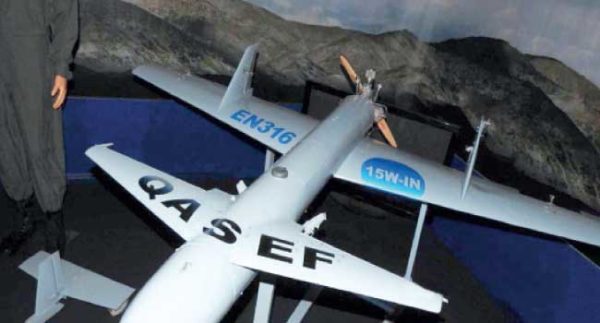
For many of the national security teams that monitor threats on the U.S., the apparent drone strike Saturday on the heart of Saudi Arabia’s oil production facilities was the realization of their worst fears.
Houthi rebels battling Saudi Arabia in Yemen took responsibility for the attack and said they used drones, though U.S. officials have said Iran was behind the attack and that at least some cruise missiles may have been used.
The attack underscored fears raised by U.S. security officials and experts in terrorism about the rapid evolution of technologies that could have allowed inexpensive devices to pierce Saudi defenses in a way that a traditional air force could not: flying long distances to drop potent bombs that apparently set vast portions of the Saudi petroleum infrastructure ablaze.
“The bottom line is that we are likely to see many more of these sorts of attacks, and in particular, coordinated attacks on multiple targets are likely, possibly in tandem with a cyberattack component,” Milena Rodban, an independent risk consultant based in Washington, said in an email.
The risk is hardly new, though, for law enforcement and homeland security officials. FBI Director Christopher Wray in October warned a Senate committee that civilian drones pose a “steadily escalating threat.” The devices are likely to be used by terrorists, criminal groups or drug cartels to carry out attacks in the U.S., he said.
Dozens of incidents in recent years have hinted at the risks, from the mysterious drone flying at London’s Gatwick Airport in December that disrupted operations for days, to recent assassination attempts using the devices in Yemen and Venezuela.
But even as the threat is well documented and understood, the counter-measures necessary to prevent or repel an attack are far murkier.
There is currently no requirement on how to track the millions of civilian drones plying the U.S. skies. The Federal Aviation Administration has spent the past two years crafting regulations requiring small civilian drones to install radio-identification technology after the FBI and Department of Homeland Security objected to widening public use of the devices. A proposed regulation is expected later this year, but may not be completed for a year or more.
Identifying Drones
Meanwhile, the FAA has cautioned airports about acquiring anti-drone technology. The agency in recent years has tested radars and other systems designed to identify drone intruders, but they all had significant blind spots.
The military has more options to combat drones, but some technologies such as jamming radio signals or firing weapons aren’t permitted in civilian environments.
And, as the Saudi Arabia attacks appear to demonstrate, even a nation with a sophisticated military and a large budget for defense is still vulnerable, said Jeffrey Price, an aviation management professor at Metropolitan State University of Denver who also works as a security consultant.
The implication of Saturday’s attacks are enormous, Price said. They not only highlight the growing technical capability of rebel groups, but could also serve as inspiration for home-grown terrorists in the U.S. who may be motivated by the Islamic State or al-Qaeda, he said.
‘New Spin’
“Flying a drone, that puts a new spin on things,” he said. “It enables attacks that previously weren’t able to be conducted with that level of stealth and detachment from the attacker.”
Few details about the attack have emerged. Secretary of State Michael Pompeo blamed Iran, which is aligned with the Houthi rebels, and said there was no evidence it originated in Yemen.
Iranian Foreign Ministry spokesman Abbas Mousavi rejected Pompeo’s assertions, calling them “blind and fruitless accusations.”
Two administration officials who asked not to be identified discussing internal deliberations told reporters on Sunday that cruise missiles may have been used in the attacks. The officials didn’t rule out that armed drones were used as well, even as they rejected the Houthi claims that they mounted the attacks using the pilotless aircraft.
The range from Yemen was far beyond the distance of anything the Houthis have ever done, the officials said.
Quad Copters
Price and others said they doubted that the small quad copters that have proliferated and can be bought online or in electronics stores were used in the Saudi attacks. Those battery-powered devices have limited range and can’t carry more than a pound or so of explosives.
However, many nations, including Israel and Iran, have demonstrated the ability to build sophisticated flying devices that are relatively small and stealthy, while also capable of carrying powerful explosive devices.
A 2018 United Nations report found that Iran had helped the Houthis build a drone known as the Qasef-1, which was based on the Iranian-built Ababil-T.
In mid-2018, the Houthi forces developed a new, longer-range drone known as the UAV-X, according to another UN report earlier this year. It’s capable of carrying a 40-pound (18-kilogram) warhead and flying more than 745 miles (1,200 kilometers).
Modern computer chips and global-positioning satellite tracking are making such drones more capable all the time, they said. And they are far cheaper to build than the multimillion-dollar Reaper drones used by the U.S. military.
Price said he raises the subject of drone security at the seminars he regularly conducts at airports around the U.S., and the answer is always the same.
“I literally ask them, what are you doing about drones?” he said. “Everyone groans.”

Leave a Reply
You must be logged in to post a comment.